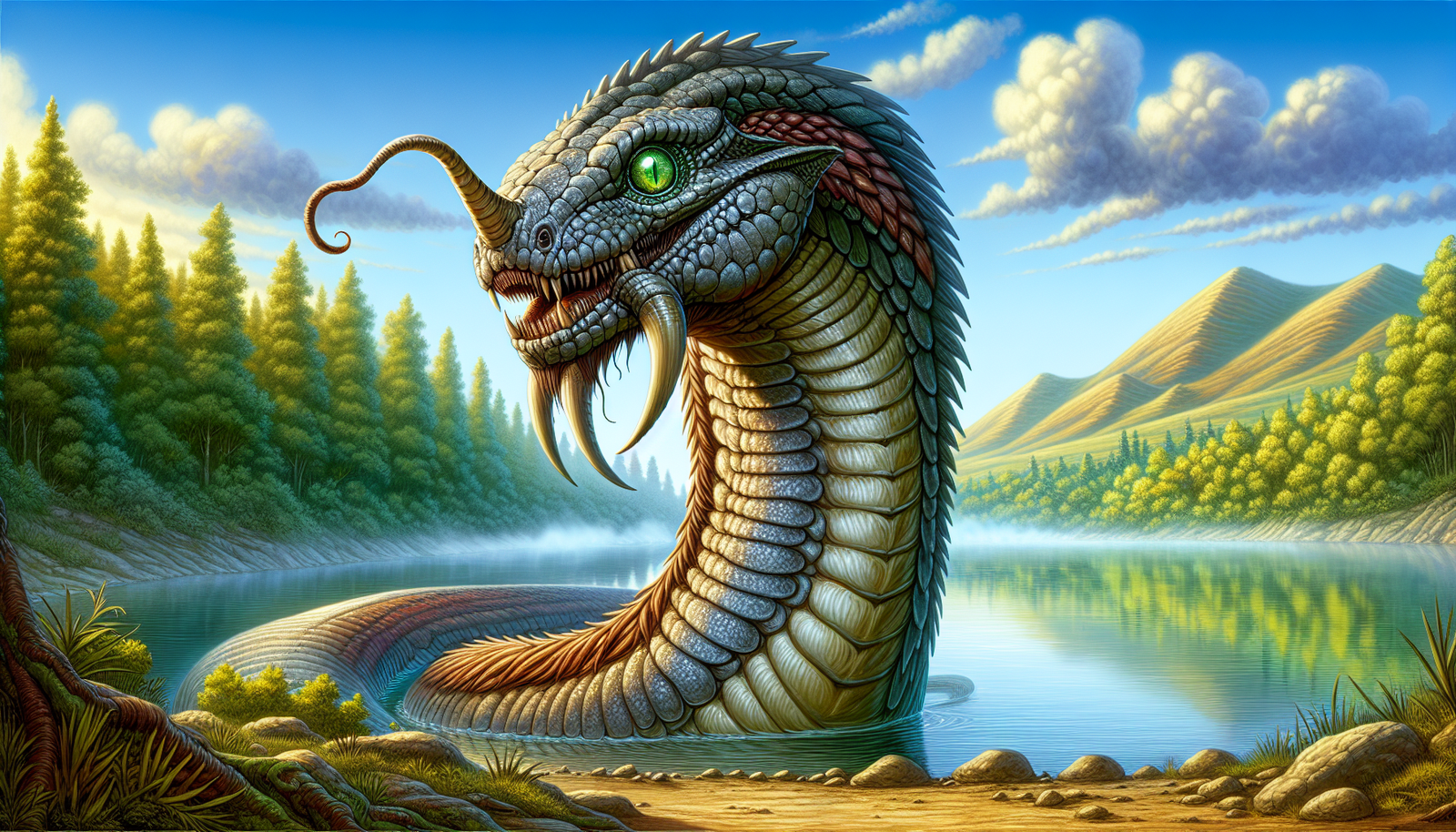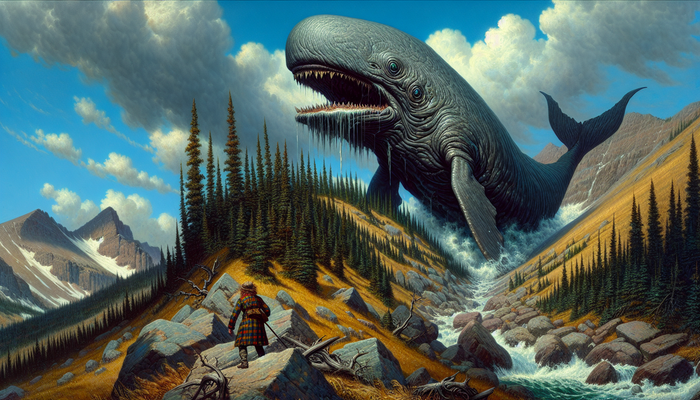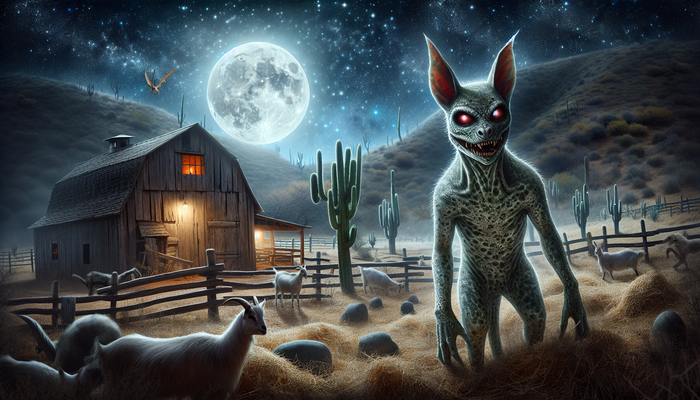Discovering the Walgren Lake Monster: Nebraska's Legendary Cryptid

By Jack Sullivan, Cryptozoologist
In the heart of Nebraska's Sandhills, a legend lurks beneath the placid waters of Walgren Lake. For nearly a century, tales of a monstrous creature have captivated locals and visitors alike, earning this modest 50-acre body of water a place among America's most intriguing cryptozoological hotspots. The Walgren Lake Monster, also known as the Alkali Lake Monster or by its grandiose Latin name Giganticus Brutervious, stands as Nebraska's answer to Scotland's famed Loch Ness Monster.
But what exactly is hiding in the depths of this unassuming lake? Is it a remnant from prehistoric times, a misidentified local animal, or perhaps the product of overactive imaginations fueled by sensational journalism? To unravel this mystery, we must dive deep into the murky waters of folklore, eyewitness accounts, and the very human desire to believe in the extraordinary.
The Origins of a Legend
The story of the Walgren Lake Monster begins in the early 1920s, a time when America was ripe with tales of the strange and unexplained. Walgren Lake, then known as Alkali Lake, was a quiet spot near the small town of Hay Springs, Nebraska. The lake's alkaline waters had long been a source of local interest, but it was about to become famous for something far more sensational than its chemical composition.
In 1921, the Hay Springs News published the first credible report of an unusual creature in the lake. The article, tantalizingly titled "If It Isn't a Whale It's a Whaler of An Animal," set the stage for what would become a local legend. Initial descriptions were vague, speaking of a large animal unlike anything seen before in the area. But it was enough to spark curiosity and set tongues wagging.
The watershed moment came in 1923 when a local man named J.A. Johnson claimed to have had a close encounter with the beast. Johnson's account was vivid and detailed, describing a creature that defied easy explanation. According to Johnson, he and two companions were camping near the lake when they spotted something extraordinary just 60 feet from shore.
The monster, as Johnson described it, was a sight to behold. It stretched an incredible 40 feet in length, with rough, grayish-brown skin that glistened in the light. But it was the creature's head that truly captured the imagination. Johnson spoke of a horn-like protrusion between its eyes and nostrils, giving it an almost prehistoric appearance. The beast's body, while reminiscent of an alligator, was far larger and heavier than any known species.
As Johnson and his friends watched in awe, the creature reportedly let out a "dreadful roar" that echoed across the water. It thrashed its powerful tail, creating waves that threatened to swamp their small boat, before diving beneath the surface and disappearing from view.
Johnson's tale spread like wildfire. It wasn't long before the Omaha World-Herald picked up the story, catapulting the Walgren Lake Monster to statewide fame. The creature's notoriety grew to such an extent that even the London Times reported on the strange happenings in this remote corner of Nebraska.
The Media Sensation Takes Hold
As news of the monster spread, it captured the public imagination in a way that few stories could. The 1920s were a time of rapid change and scientific advancement, but they were also an era when the world still held mysteries. The idea that a prehistoric creature could be lurking in a Nebraska lake was thrilling to many.
Newspapers across the state began running regular updates on the monster, each seemingly more sensational than the last. The creature grew in size and ferocity with each retelling. Soon, stories circulated of the monster coming ashore to devour livestock, leaving farmers in fear for their herds.
But perhaps the most intriguing aspect of the media frenzy was the involvement of one John G. Maher. A local politician and newspaperman, Maher had a reputation for creating elaborate hoaxes to boost circulation and entertain readers. His previous stunts included planting a fake "petrified man" for archaeologists to discover and convincing locals that the British Navy was sailing up the Missouri River to exact revenge on Irish immigrants.
Maher's role in propagating the Walgren Lake Monster story cannot be overstated. He fed increasingly outlandish tales to newspapers, each one adding to the creature's mystique. Under Maher's influence, the monster evolved from a simple lake dweller to a supernatural being capable of controlling the weather and creating disorienting mists.
The question remains: was Maher the mastermind behind the entire legend, or was he simply capitalizing on existing local folklore? The truth, as is often the case with such tales, likely lies somewhere in between.
A Monster of Many Faces
As the legend of the Walgren Lake Monster grew, so too did the variety of descriptions attributed to it. While Johnson's account of an alligator-like beast remained the most famous, other eyewitnesses came forward with their own, often conflicting, reports.
Some described the creature as a giant catfish, its whiskers trailing behind it as it swam through the murky waters. Others spoke of a massive mudpuppy, an amphibian of monstrous proportions. Still others insisted it was more akin to a plesiosaur, a long-necked marine reptile thought to have gone extinct millions of years ago.
The monster's size was equally variable in these accounts. While Johnson had placed it at 40 feet, other reports ranged from a more modest 10 feet to an almost unbelievable 100 feet in length. This inconsistency in descriptions led some to question the validity of the sightings, while others saw it as proof of multiple creatures inhabiting the lake.
Perhaps the most intriguing aspect of the Walgren Lake Monster's evolution was the supernatural abilities attributed to it over time. As the legend grew, so too did the creature's powers. It was said that the monster's movements could cause earthquakes, making farmers feel seasick for miles around. When it came ashore, supposedly to feast on cattle, it was accompanied by a thick, green mist that disorientated travelers and obscured its true form.
These fantastical elements added a new dimension to the legend, transforming it from a simple cryptozoological mystery into something more akin to a folktale or myth. The monster became a symbol of the unknown, a manifestation of the wild and untamed nature that still existed in the hearts of many Nebraskans.
A Community Embraces Its Monster
Far from being frightened by the tales of a monstrous creature in their midst, the people of Hay Springs and the surrounding area embraced the Walgren Lake Monster as part of their cultural identity. The legend became a source of pride, a way for this small Nebraska town to distinguish itself and attract attention from the wider world.
Local businesses began to capitalize on the monster's fame. Souvenir shops sprang up, selling t-shirts, postcards, and other memorabilia featuring artistic renditions of the creature. These depictions often drew from Johnson's original description, showing a scaly, horned beast emerging from the waters of Walgren Lake.
The monster also became a central figure in local festivals and events. During the Hay Springs Centennial celebration in 1985, the town went all out in honoring its aquatic resident. Parade floats featured elaborate monster costumes, and children participated in monster-themed games and activities. The celebration even coincided with what some claim was the last reported sighting of the creature, though skeptics argue this was more likely a case of festival enthusiasm than an actual encounter.
Local artists found inspiration in the legend, creating murals and sculptures that brought the monster to life in vibrant color and form. These artistic interpretations not only added to the town's charm but also served to keep the legend alive for new generations. A particularly striking mural in downtown Hay Springs depicts the monster rising from the lake, its green scales glistening and its eyes glowing with an otherworldly light.
The impact of the Walgren Lake Monster on the community extended beyond mere tourism and festivities. It became a part of the area's oral tradition, with stories passed down from grandparents to grandchildren. Local schools incorporated the legend into their curriculum, using it as a jumping-off point for lessons on local history, folklore, and even critical thinking.
One of the most dedicated keepers of the monster's legacy is Mary Hansen, a longtime Hay Springs resident. Hansen has meticulously compiled a scrapbook filled with newspaper clippings, photographs, and personal accounts related to the Walgren Lake Monster. Her collection spans decades and serves as a valuable resource for those interested in the history of the legend.
"I believe there was something out there," Hansen has been quoted as saying. "I don't think there's much in there currently, but people saw something." Her words encapsulate the attitude of many locals – a mix of belief, skepticism, and a deep appreciation for the role the legend has played in shaping their community's identity.
The Science Behind the Legend
While the Walgren Lake Monster has captured imaginations for nearly a century, scientists and skeptics have long sought more mundane explanations for the reported sightings. The Nebraska State Historical Society suggests that many of the encounters may have been misidentifications of local wildlife, particularly unusually large beavers.
Beavers, while not typically associated with monster sightings, can grow to impressive sizes. A large beaver swimming at the surface, especially when viewed from a distance or in poor lighting conditions, could potentially be mistaken for something more exotic. The beaver's flat, paddle-like tail could account for some descriptions of the monster's powerful appendage.
Other potential candidates for misidentification include large catfish or sturgeon, both of which can grow to substantial sizes and have been known to inhabit lakes and rivers in the region. The mudpuppy, a type of aquatic salamander, has also been suggested as a possible source for some of the sightings, though its typically small size makes it an unlikely candidate for the more dramatic accounts.
Ecologists point out that Walgren Lake's ecosystem is unlikely to support a large, unknown predator. The lake, while picturesque, is relatively small and shallow, with a maximum depth of only about 12 feet. Such an environment would make it difficult for a creature of the reported size to remain hidden for long periods, let alone sustain itself over generations.
Furthermore, the alkaline nature of the lake – which gave it its original name of Alkali Lake – creates a unique and somewhat challenging environment for aquatic life. While some species thrive in these conditions, they tend to be specialized and well-documented, making the presence of an unknown large predator even less likely.
Despite these scientific explanations, many continue to believe in the possibility of the Walgren Lake Monster's existence. This persistence of belief in the face of contradictory evidence is a fascinating aspect of cryptozoology and folklore studies. It speaks to the human desire for mystery and the unknown, even in an age of scientific enlightenment.
The Power of Folklore in Shaping Community Identity
The Walgren Lake Monster, whether real or imagined, has played a significant role in shaping the identity of Hay Springs and the surrounding area. This phenomenon is not unique to Nebraska; communities around the world have embraced local legends as a way of distinguishing themselves and creating a sense of shared history and culture.
Folklore experts argue that these legends serve important social functions. They provide a common narrative that binds community members together, creating a shared experience that transcends generations. The Walgren Lake Monster, in this context, is more than just a potential cryptid – it's a symbol of the area's uniqueness and a source of local pride.
Moreover, the legend has economic implications. Cryptid tourism, while not a major industry, does bring curious visitors to Hay Springs. These tourists patronize local businesses, stay in local accommodations, and spread the story of the monster to their own communities, further enhancing the legend's reach.
The monster also serves as a gateway to broader discussions about local history, ecology, and the importance of preserving natural habitats. Even those who don't believe in the creature's existence can appreciate the ways in which the legend has helped to highlight the beauty and uniqueness of Walgren Lake and the surrounding Sandhills region.
Modern Perspectives and the Future of the Legend
In recent years, reported sightings of the Walgren Lake Monster have become increasingly rare. The last widely publicized sighting occurred in 1985, coinciding with the Hay Springs Centennial celebration. This timing has led some to speculate that the "sighting" may have been more about community spirit than an actual encounter.
Despite the lack of recent sightings, interest in the Walgren Lake Monster remains strong. Cryptozoology enthusiasts continue to debate the creature's existence on online forums and at conferences. Some argue that the monster may have gone into hibernation or migrated to other bodies of water, while others maintain that it was always more legend than reality.
Local attitudes towards the monster have evolved as well. While many older residents remember a time when belief in the creature was more widespread, younger generations tend to view the legend with a mix of affection and amusement. The monster has become a beloved mascot of sorts, a quirky piece of local history that sets Hay Springs apart from other small towns.
Tourism officials have embraced this shift, marketing Walgren Lake as a place where visitors can enjoy outdoor activities while also indulging in a bit of monster-hunting fun. Guided tours of the lake often include retellings of famous sightings and discussions of the legend's impact on the community.
The Walgren Lake State Recreation Area, which encompasses the lake and surrounding land, continues to attract visitors year-round. While many come for the fishing, boating, and camping opportunities, the possibility of spotting Nebraska's Loch Ness monster adds an extra layer of excitement to their outdoor adventures.
As we look to the future, it's clear that the Walgren Lake Monster will continue to play a role in the cultural landscape of Nebraska. Whether viewed as a potential cryptid, a colorful piece of local folklore, or simply a fun story to share around the campfire, the legend has become an indelible part of the region's identity.
The story of the Walgren Lake Monster is more than just a tale of an elusive creature. It's a window into the power of storytelling, the human need for mystery, and the ways in which communities create and sustain their unique identities. As long as there are those willing to keep the legend alive – whether through artistic expression, oral tradition, or the simple act of peering hopefully into the waters of Walgren Lake – Nebraska's most famous monster will continue to capture imaginations and inspire wonder.
In the end, perhaps the true value of the Walgren Lake Monster lies not in proving its existence, but in the ways it brings people together, sparks curiosity about the natural world, and reminds us that even in our modern age, there's still room for a little mystery and magic in our lives.
From Bigfoot to UFOs: Hangar 1 Publishing Has You Covered!
Explore Untold Stories: Venture into the world of UFOs, cryptids, Bigfoot, and beyond. Every story is a journey into the extraordinary.
Immersive Book Technology: Experience real videos, sights, and sounds within our books. Its not just reading; its an adventure.



























